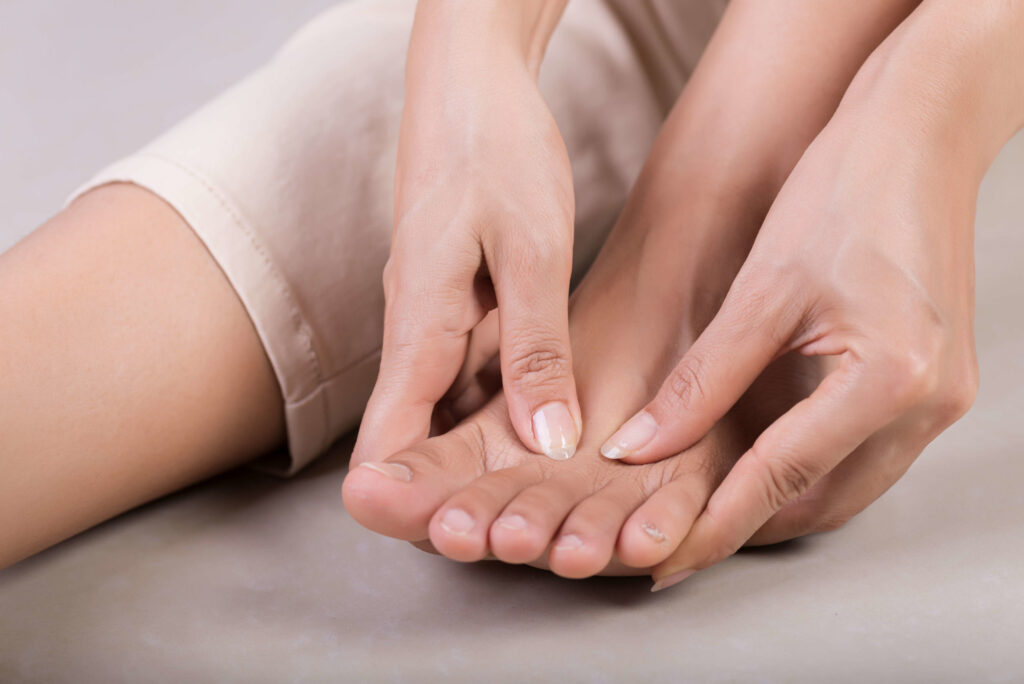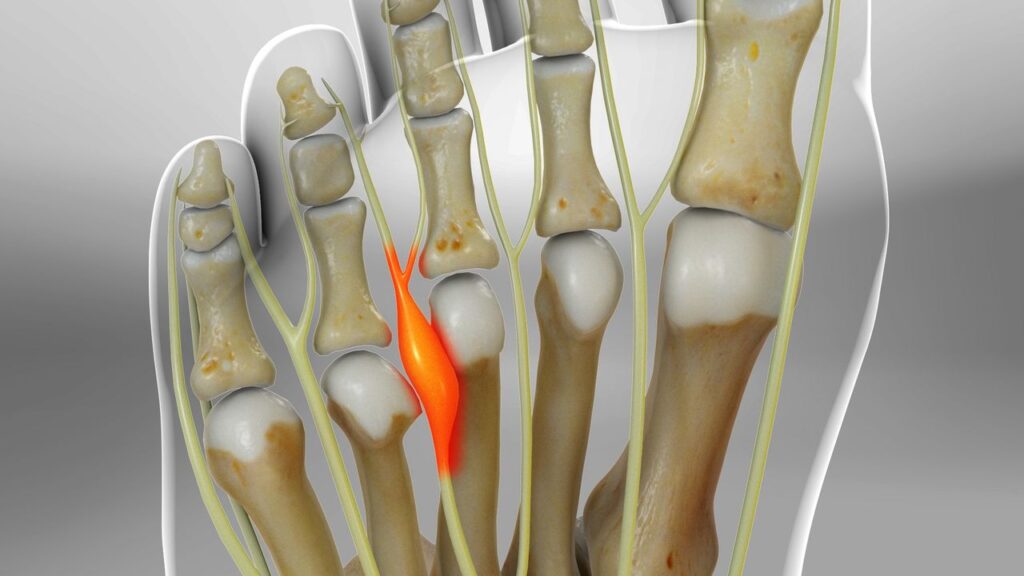Morton's Neuroma
Morton’s Neuroma
Table of Contents
What is Morton’s Neuroma?

Morton’s neuroma is a painful condition that affects the ball of your foot, most commonly between the third and fourth toes. It involves a thickening of the tissue around a nerve leading to your toes. This thickened nerve can become irritated and inflamed, often feeling like you’re standing on a pebble or bunched-up sock.
Though it’s called a “neuroma,” this isn’t a tumor — it’s a nerve entrapment condition that develops over time, especially with improper footwear or repetitive stress.
What are the symptoms of Morton’s neuroma?

The condition may develop gradually, with symptoms worsening over time. People with Morton’s neuroma often report:
A sharp, burning pain in the ball of the foot
Tingling or numbness in the toes
Feeling like there’s something in the shoe or a fold in the sock
Pain that worsens with activity or tight shoes
Relief when removing footwear or massaging the foot
The symptoms may come and go at first but typically become more persistent if left untreated.
What causes Morton’s neuroma?
Morton’s neuroma develops when the nerve between your toes is compressed or irritated. Common causes and risk factors include:
Wearing tight, narrow, or high-heeled shoes
Repetitive stress on the forefoot (e.g., running, sports)
Foot deformities such as flat feet, bunions, or hammertoes
Occupations or activities requiring prolonged standing or walking
Women are more likely to develop Morton’s neuroma than men, primarily due to footwear choices.
How is Morton’s neuroma diagnosed?
Toetal Podiatry performs a comprehensive physical exam, looking for tenderness, a palpable lump, or a clicking sensation between the toes (Mulder’s click).
Diagnosis may include:
Ultrasound or in-office X-rays to rule out fractures or arthritis
MRI for detailed imaging if needed
Diagnostic injections to confirm that the pain source is nerve-related
Early diagnosis is key to preventing chronic nerve damage.
Would I need surgery for Morton’s neuroma?
Surgery is only recommended if conservative treatments fail and the pain becomes debilitating.
Surgical options include:
Neurectomy – removal of the affected nerve
Decompression surgery – relieving pressure by cutting nearby structures
Minimally invasive approaches when possible for faster recovery
Post-surgical recovery may include physical therapy and temporary lifestyle adjustments. Toetal Podiatry will design a treatment plan tailored to your activity level and goals.
FAQs about Morton’s Neuroma
Q: Can Morton’s neuroma go away on its own?
A: In early stages, symptoms may subside with rest, shoe changes, and orthotics — but the condition often worsens without intervention.
Q: Is Morton’s neuroma a permanent condition?
A: Not necessarily. With timely treatment, symptoms can be managed or resolved. Chronic cases may require surgery.
Q: What shoes are best for Morton’s neuroma?
A: Wide, low-heeled shoes with cushioned soles and a roomy toe box are ideal.
Q: How long does treatment take?
A: Many patients feel relief within weeks of conservative treatment. More advanced cases may need multiple sessions or procedures.
Our Reviews
EXCELLENTTrustindex verifies that the original source of the review is Google. Dr. Rahman was amazing. She really explained everything clearly, she worked hard with the pharmacy and my insurance company to make sure I received the best care. Would definitely recommend.Trustindex verifies that the original source of the review is Google. Dr Rahman was amazing and so helpful! Would highly recommendTrustindex verifies that the original source of the review is Google. Dr. Wu is is amazing! Super knowledgeable, patient, and caring. She took the time to explain everything clearly and made me feel comfortable throughout the visit. The staff was also very welcoming and efficient. I felt like I was in great hands from start to finish — highly recommend if you’re looking for a podiatrist who really listens and cares.Trustindex verifies that the original source of the review is Google. I was having very bad plantar fasciitis, and Dr. Rahman prescribed a pair of night boots to stretch me out. When I started this therapy, my pain was an order of magnitude better after a single day of stretching. And as time has continued, it's gotten better and better. I've had foot pain for most of my life and to be relieved of it now is huge for me.Trustindex verifies that the original source of the review is Google. Great staff that helped my pain turn into laughter. I recommend.Trustindex verifies that the original source of the review is Google. Great doctor, helpful solutions!!Trustindex verifies that the original source of the review is Google. Helpful, resourceful and knowledgeable. Dr. Erfanian was great.
Our Locations
Contact Us
- 917-261-4291
- 917-594-4881
Locations
- 274 Madison Ave #1001, New York, NY 10016
- 26 Broadway Suite 931, New York, NY 10004

